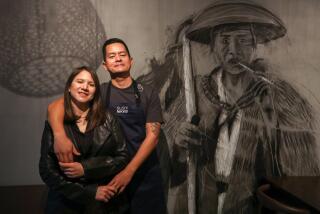A Look at the Career Arc of Japan’s Bad Boy of Literature
- Share via
Jun’ichiro Tanizaki (1886-1965) was a bad boy of Japanese literature before and after he became a grand old man. These six stories, dating from 1911 to 1955 and thus representing the full arc of his career, will introduce Western readers who know Tanizaki primarily through his masterpiece, “The Makioka Sisters,” to his more typical manner: impish, decadent, outrageous.
The destruction of World War II evidently moved Tanizaki and concentrated his energies as nothing else did. In “The Makioka Sisters,” a novel of almost Tolstoyan sweep, he re-created the prewar life of an upper-class family in Osaka. The novel, which ends in 1943--before the fire-bombings that would obliterate that world forever--combines a robust realism with scenes of evanescent beauty that evoke “The Tale of Genji” (which Tanizaki had translated into modern Japanese) and reach out to the nation’s timeless, fireproof heritage.
“The Gourmet Club,” however, brings us the Tanizaki more familiar to generations of Japanese readers, the Tanizaki of “The Key” and “Diary of a Mad Old Man”--shorter novels that, like these stories, concern themselves with sensuality, obsession and secrecy.
In “The Children,” a rich boy, a weakling at school, invites a classmate, the narrator, to his home to play. They are joined by his sister and a lower-class boy who is a bully at school. Unsupervised by adults, the play turns sadomasochistic and the roles are reversed. First the rich boy, then the sister become a capricious tyrant, and the narrator finds slavery almost too pleasurable to flee.
In “The Secret,” a jaded Tokyo playboy seeks new thrills by dressing as a woman and mingling with movie-house crowds. He meets a former lover who sees through the disguise. As their affair resumes, she tries to hold his interest this time by keeping her current identity and the location of their trysting place a secret--and he, perversely, tries to solve the mystery that gives him so much pleasure.
In the title story, the thrills to be sought are gastronomical. A group of rich idlers has wearied of the food even the best Tokyo restaurants can offer. Their leader, the Count, happens upon a club of expatriate Chinese with similar interests. It bars Japanese, but a kindly, tipsy member lets the Count spy on it through a crack in the wall of an opium den next door. He discovers a world where repulsive ingredients, such as pigs’ embryos, can taste like ambrosia and where the serving girls’ fingers play a role.
In “Mr. Bluemound,” a film director married to a glamorous star named Yurako meets a creepy older man who claims to have studied the films so minutely that he knows Yurako’s body better than her husband does. The man unveils a collection of 30 Yurako dolls he has made, lifelike even in their smells and secretions. In “Manganese Dioxide Dreams,” the elderly narrator looks in the toilet and summons up images of French actress Simone Signoret and a court lady in ancient China who was executed in a particularly gruesome way.
Even in the earliest stories, Tanizaki’s style is striking in its assurance--he knew he was going to be a master--and in its appreciation of tastes, odors, music, the feel of fabrics, the warmth of skin. Such delights are proscribed by the teachers at the Kyoto monastery where “The Two Acolytes” is set. One boy leaves and follows the worldly path that Tanizaki took, but the story sympathizes more with the boy who remains faithful to Buddhist teachings.
“Perhaps it is an imaginative working-out of a crisis the adolescent Tanizaki underwent,” the translators say. “He came to realize that his own destiny was tied to the world of beauty, both as the object of sensuous desire and the subject of aesthetic endeavor, [but] in this story, he seems to pay tribute to the part of himself that might have chosen the other path.”
More to Read
Sign up for our Book Club newsletter
Get the latest news, events and more from the Los Angeles Times Book Club, and help us get L.A. reading and talking.
You may occasionally receive promotional content from the Los Angeles Times.










